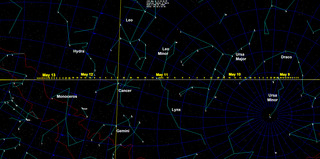Comet IRAS–Araki–Alcock
Perihelion 0.99134097 ± 2.876×10−7 AU | | |
| 98.021909±0.21517 AU | ||
| Eccentricity | 0.9898865 | |
| 970.49 years | ||
| Inclination | 73.2513669° | |
| Earth MOID | 0.00583 AU (872000 km; 542000 mi) | |
| Physical characteristics | ||
| Dimensions | 9.2 km in diameter[2] | |
| Albedo | 0.02[2] | |
| 12.599[2] | ||
Infrared Astronomical Satellite
(IRAS)
Comet IRAS–Araki–Alcock (formal designation C/1983 H1, formerly 1983 VII) is a long-period
astronomers, George Alcock of the United Kingdom and Genichi Araki of Japan. Both men were schoolteachers by profession, although Alcock was retired. Alcock had made his discovery simply by observing through the window of his home, using binoculars.[3][4] During the closest approach, the comet appeared as a circular cloud about the size of the full moon, having no discernible tail, and shining at a naked eye magnitude of 3–4. It swept across the sky at an angular speed of about 30 degrees per day. On May 11 the comet was detected on radar by Arecibo Observatory and Goldstone Solar System Radar making it the first comet detected by two different radar systems.[5] A second detection was made by Goldstone on 14 May.[5]
It is a long-period comet, with an orbital period of about 970 years,Vega and Cygnus and produces 1 or 2 meteors an hour in mid-May with a peak between 9 May and 11 May.
Flyby comparison
Comet IRAS–Araki–Alcock made its closest approach to Earth in 1983, at a distance of about 0.0312
P/2016 BA14, passed at a distance of 0.0237 AU (3,550,000 km; 2,200,000 mi) on 22 March 2016.[10]
1983 Flyby
 The comet passed from north to south between 9 May to 13 May, passing through Ursa Major towards Cancer. Its motion is marked every 2 hours here. |
 Moving north to south, it crossed just inside the Earth's orbit on 11 May. |
References
- ^ a b c "JPL Orbital Elements: C/1983 H1 (IRAS–Araki–Alcock)". Retrieved 7 April 2020.
1983-10-04 last obs (arc=160 days)
- ^ a b c "JPL Orbital Elements: C/1983 H1 (IRAS–Araki–Alcock)". Retrieved 28 June 2012.
1983-10-04 last obs (arc=160 days)
- ^ "Obituary of George Alcock", BBC News, 21 December 2000.
- ^ "Outbreak of Comet Fever", Time, 23 May 1983. "I've discovered a wonderful star ... Now I've got to discover a wonderful wife."
- ^ . Retrieved 22 November 2020.
- ^ "Eta Lyrids". Meteor Showers Online. Archived from the original on 5 May 2012. Retrieved 21 November 2008.
- ^ "Closest Approaches to the Earth by Comets". Minor Planet Center. Retrieved 28 June 2012.
- ^ "JPL Close-Approach Data: C/1983 H1 (IRAS–Araki–Alcock)". Retrieved 28 June 2012.
1983-10-04 last obs (arc=160 days)
- ^ "JPL Close-Approach Data: P/1999 J6 (SOHO)". Retrieved 28 June 2012.
2010-04-22 last obs (arc=10.9 yr; JFC)
- ^ "NEO Earth Close Approaches". Archived from the original on 7 March 2014. Retrieved 4 March 2014.
